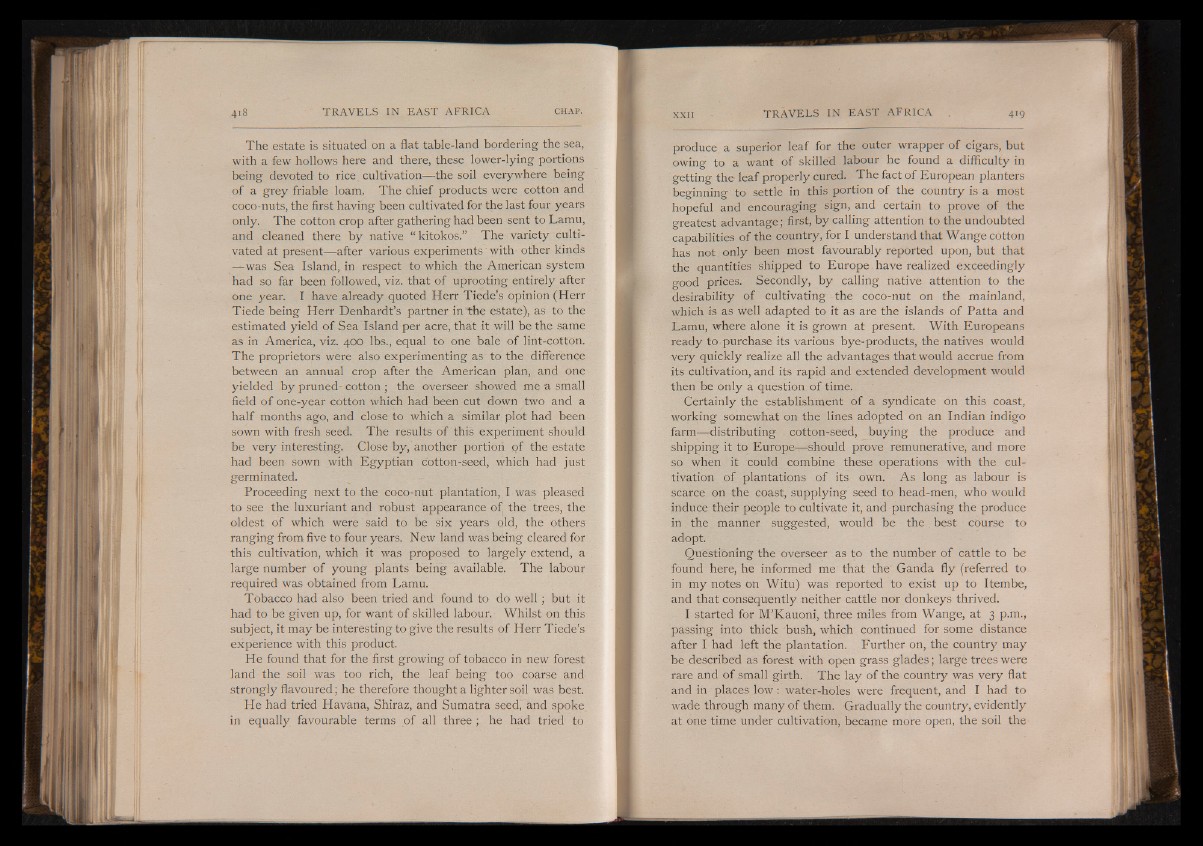
The estate is situated on a flat table-land bordering the sea,
with a few hollows here and there, these lower-lying portions
being devoted to rice cultivation— the soil everywhere being
of a grey friable loam. The chief products were cotton and
coco-nuts, the first having been cultivated for the last four years
only. The cotton crop after gathering had been sent to Lamu,
and cleaned there by native “ kitokos.” The variety cultivated
at present— after various experiments with other kinds
-—was Sea Island, in respect to which the American system
had so far been followed, viz. that of uprooting entirely after
one year. I have already quoted Herr Tiede’s opinion (Herr
Tiede being Herr Denhardt’s partner in the estate), as to the
estimated yield of Sea Island per acre, that it will be the same
as in America, viz. 400 lbs., equal to one bale of lint-cotton.
The proprietors were also experimenting as to the difference
between an annual crop after the American plan, and one
yielded by pruned-cotton ; the overseer showed me a small
field of one-year cotton which had been cut down two and a
half months ago, and close to which a similar plot had been
sown with fresh seed. The results of this experiment should
be very interesting. Close by, another portion qf the estate
had been sown with Egyptian cotton-seed, which had just
germinated.
Proceeding next to the coco-nut plantation, I was pleased
to see the luxuriant and robust appearance of the trees, the
oldest of which were said to be six years old, the others
ranging from five to four years. New land was being cleared for
this cultivation, which it was proposed to largely extend, a
large number of young plants being available. The labour
required was obtained from Lamu.
Tobacco had also been tried and found to do w e ll; but it
had to be given up, for want of skilled labour. Whilst on this
subject, it may be interesting to give the results of Herr Tiede’s
experience with this product.
He found that for the first growing of tobacco in new forest
land the soil was too rich, the leaf being too coarse and
strongly flavoured; he therefore thought a lighter soil was best.
He had tried Havana, Shiraz, and Sumatra seed, and spoke
in equally favourable terms of all three ; he had tried to
produce, a superior leaf for the outer wrapper of cigars, but
owing to a want of skilled labour he found a difficulty in
getting the leaf properly cured. The fact of European planters
beginning to settle in this portion of the country is a most
hopeful and encouraging sign, and certain to prove of the
greatest advantage; first, by calling attention to the undoubted
capabilities of the country, for I understand that Wange cotton
has not only been most favourably reported upon, but that
the quantities shipped to Europe have realized exceedingly
good prices. Secondly, by calling native attention to the
desirability of cultivating the coco-nut on the mainland,
which is as well adapted to it as are the islands of Patta and
Lamu, where alone it is grown at present. With Europeans
ready to purchase its various bye-products, the natives would
very quickly realize all the advantages that would accrue from
its cultivation, and its rapid and extended development would
then be only a question of time.
Certainly the establishment of a syndicate on this coast,
working somewhat on the lines adopted on an Indian indigo
farmfi-distributing cotton-seed, buying the produce and
shipping it to Europe— should prove remunerative, and more
so when it could combine these operations with the cultivation
of plantations of its own. As long as labour is
scarce on the coast, supplying seed to head-men, who would
induce their people to cultivate it, and purchasing the produce
in the manner suggested, would be the best course to
adopt.
Questioning the overseer as to the number of cattle to be
found here, he informed me that the Ganda fly (referred to
in my notes on Witu) was reported to exist up to Itembe,
and that consequently neither cattle nor donkeys thrived.
I started for M’Kauoni, three miles from Wange, at 3 p.m.,
passing into thick bush, which continued for some distance
after I had left the plantation. Further on, the country may
be described as forest with open grass glades; large trees were
rare and of small girth. The lay of the country was very flat
and in places low : water-holes were frequent, and I had to
wade through many of them. Gradually the country, evidently
at one time under cultivation, became more open, the soil the